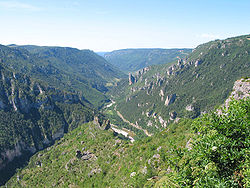- Gorges du Tarn
-
The Gorges du Tarn is a canyon formed by the Tarn River between the Causse Méjean and the Causse de Sauveterre, in southern France. The canyon, mainly located in the Lozère département, and partially in the Aveyron département, is about 53 kilometres (33 mi)-long (from the village of Quézac to Le Rozier, from 44°22′30″N 3°31′15″E / 44.375°N 3.52083°E to 44°11′36″N 3°12′20″E / 44.19333°N 3.20556°ECoordinates: 44°11′36″N 3°12′20″E / 44.19333°N 3.20556°E) and 400m to 600m deep.
Contents
Geography
The architecture of the gorges is relatively simple, with mesozoic limestone plateaux downstream presenting sub-vertical cliffs, though faults like the Hauterive Fault upstream explain the important water sources in the region of Saint-Enimie (the Burle source and the Coussac source, the latter joining the Tarn in an impressive waterfall), and the more complex geology.
In the quaternary, the gorges were also affected by a volcanic activity whose traces can be found in the Sauveterre Causse, in the form of a double volcanic dip, and in the basaltic rocks next to Eglanzines.
The climate is mediterranean, with relatively mild winters and very warm summers.
Activities
Tourism is a main factor of development in the region, with activities that include :
- Hiking
- Kayaking
- Speleology in the Causses
- Visiting typical villages : Cirque de Saint-Chély-du-Tarn, ...
- Rock climbing
- Outdoor sports and leisures...
Architecture
Many castles have been built along the Gorges, most of them dating back to the Middle-Age, such as those of Castelbouc, La Caze, Hauterives, La Malène or Saint-Rome-de-Dolan…
See also
- Causses
- Tourism in Tarn
External links
Wikimedia Foundation. 2010.


